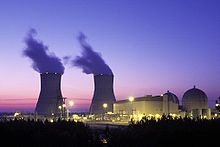Who should bear the risks of cost overruns in the construction of new nuclear power plants: electric ratepayers, the electric utility sponsoring the project, equipment vendors, contractors or others? That’s the question currently being debated at the Georgia Public Service Commission (PSC) in regard to two new nuclear units under construction at the Vogtle site. The PSC staff has proposed a Risk Sharing Mechanism (RSM) that cuts the profit paid to the plants’ sponsor, Georgia Power (Southern Co) in the event of cost overruns.

Vogtle units 1 & 2, Georgia
Per reporting by Rebecca Smith for the Wall Street Journal, under the RSM,
…the utility would suffer a cut in its return on equity proportional to the amount of any cost overrun. For example, if Georgia Power’s cost jumped to $8 billion, the company would lose $700 million in profit from the project, receiving $9.3 billion, over many years, instead of the $10 billion it would receive, as a return on its investment, if it stuck to the approved budget.
That’s asking Georgia Power to assume an 8.75% 43% share of the cost overruns, which would seem to be pretty modest substantial, although I’ve not seen any modeling that establishes what ought to be the right level.[1] Clearly putting some sort of risk onto the project sponsor seems wise as an incentive device. If the sponsor doesn’t have any skin in the game, then the forecasts it produces are less reliable and the actions it takes are likely to be less effective in minimizing costs. It’s not easy to determine the right amount of risk that should be allocated, nor to design the optimal sharing structure.
Georgia Power is objecting. According to the reporting, there are two issues.
One is the fact that this is all being decided belatedly. The PSC authorized construction of the plants a while ago, and without this RSM. Revising the terms at this date is troublesome, since Georgia Power has already invested in the project based on the terms when it was originally approved, and might not have gone forward depending upon the revised terms, as Kristi Swartz at the Atlanta Journal and Constitution reports. Reading the debate as it is unfolding, it appears that as the issue is being negotiated, one idea being floated is to impose some risk sharing, while simultaneously adjusting the base profit level to keep Georgia Power whole. This is a recognition that risk sharing increases the size of the total pie via the incentive effects, so there is then room to re-divide the pie to everyone’s advantage.
Obviously it would have been better if the PSC had imposed risk sharing as a part of the original approval, but one should be cautious in labeling the RSM as an ex post ‘taking’. I’m not a legal expert, but my reading of the discussion is that the PSC is considering the RSM under its authority to review the prudency of expenditures as they are incurred. In that sense, the proposed RSM is not a revision of the original approval, but an implementation of it. Legal experts can decide whether that is legally correct, and all of the participants can decide if that is true in substance. Georgia Power’s staff pointed out that financial markets will be evaluating whether public authorities follow through with the support originally voiced for the project, according to reporting by Errin Haines for the AP.
The second issue is the fact that cost overruns may have many different causes, many of which have nothing to do with Georgia Power. They shouldn’t be punished for things outside their control. Equipment vendors and construction companies need to be held accountable for their performance. The Federal government, too, is a player, since the Nuclear Regulatory Commission’s certification of the proposed design and other decisions also impact the timeliness and costs for the project. This point already seems to have been accepted by the PSC staff, at least in part, so that the proposed RSM has been revised to make some distinctions about the causes of the cost overruns and the allocation of risk to the PSC.
The new build nuclear units at the Vogtle site are a key test for nuclear’s near term future in the US. A central question is whether the units be built on time and within budget. Vogtle’s existing units #1 and #2 were completed at the end of the 1980s and suffered from large cost overruns like many other units in those years. Every economic analysis in which nuclear is competitive with alternatives assumes new units avoid the cost overruns of the past era. So the performance at Vogtle this time is key for the entire industry.
When Georgia authorities approved the project, they had the Public Service Commission appoint a monitor to oversee the project and warn of delays and cost increases. Last month the monitor flagged some potential problems on the horizon–see the reporting here and here. This issue will be an important one to keep an eye on in the months and years ahead.
Update: At an August meeting, the Commission unanimously rejected the proposed risk-sharing mechanism. Commissioners emphasized the power they already have to disallow recovery of any costs “imprudently” incurred. They also rejected the formulaic risk-sharing rule as not being sufficiently robust to respond to a variety of future contingencies, including new safety requirements they might wish to impose.
[1] Correction made thanks to comment by a reader: “The original budget is $6.4B – a cost over-run would be, in this example, $1.6B. Therefore, at $700M — Georgia Power’s “share of the cost overruns” would be 43%.” This takes the numbers in the Wall Street Journal‘s reporting at face value. A summary of the Risk Sharing Mechanism as revised by staff is at this link.
